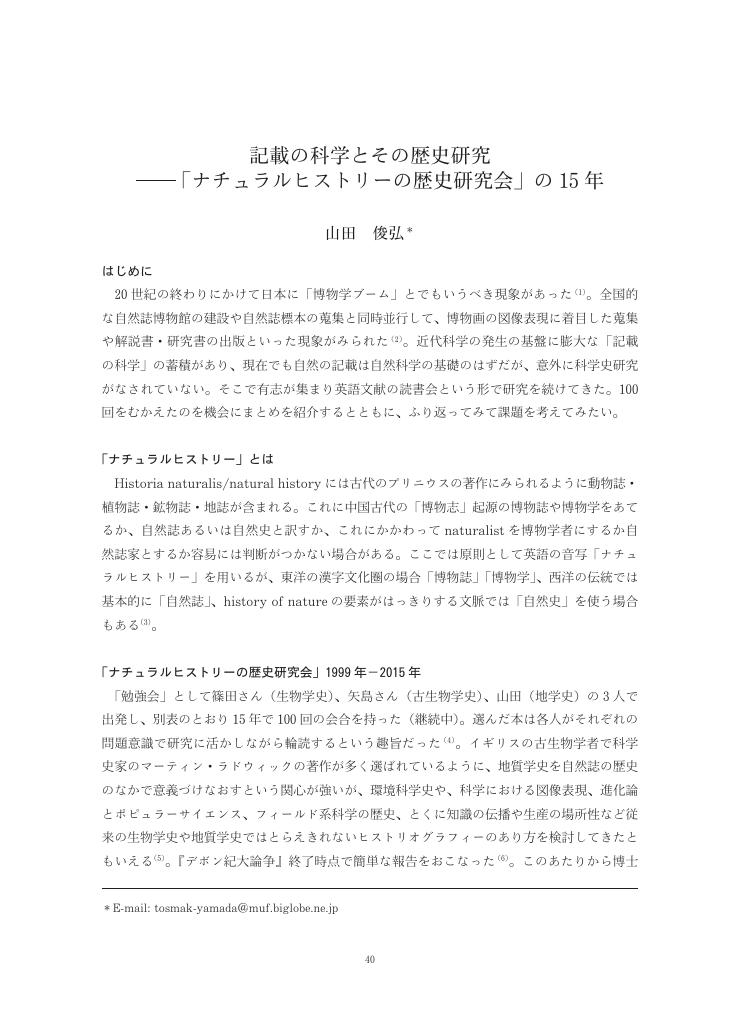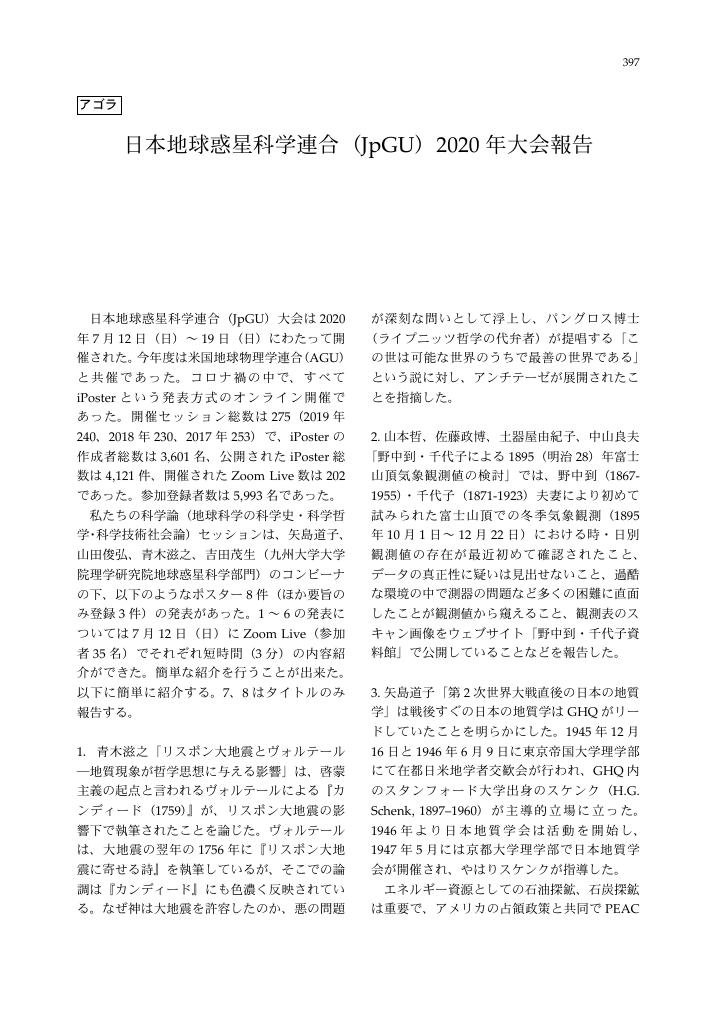- 著者
- 山田 俊弘
- 出版者
- 一般社団法人 日本科学教育学会
- 雑誌
- 科学教育研究 (ISSN:03864553)
- 巻号頁・発行日
- vol.31, no.4, pp.275-278, 2007-12-27 (Released:2017-06-30)
- 参考文献数
- 7
- 著者
- 山田 俊弘 矢島 道子 須貝 俊彦 島津 俊之
- 出版者
- 公益社団法人 東京地学協会
- 雑誌
- 地学雑誌 (ISSN:0022135X)
- 巻号頁・発行日
- vol.132, no.3, pp.217-230, 2023-06-25 (Released:2023-07-07)
- 参考文献数
- 41
The historiography of geoscience in the 20th century in Japan is reconsidered through 57 volumes of diaries (1914-1963) of Mochizuki Katsumi (1905-1963), a geology professor at Shizuoka University, from the following four viewpoints: 1) Scientific thought of geotectonics: Considering Mochizuki's own theory of geotectonics from his relations with other researchers such as Otuka Yanosuke (1903-1950), professor at the Earthquake Research Institute and the Faculty of Science of the Imperial University of Tokyo; 2) Mutual relationship between geology and geography: Tracing Mochizuki's teachings and research in the two disciplines at the higher schools of Kanazawa and Shizuoka; 3) History of geoscience education: Illustrating the transition of ‘geoscience’ including human geography, from the World War II era to the post-war period; 4) The life history of a scientist: Positioning a personal history, which records details of educational reforms in the history of universities and cultural history of Japan.
3 0 0 0 ジオコスモスの変容 : デカルトからライプニッツまでの地球論
- 著者
- 山田 俊弘
- 出版者
- 一般社団法人 日本科学教育学会
- 雑誌
- 日本科学教育学会年会論文集 31 (ISSN:21863628)
- 巻号頁・発行日
- pp.129-130, 2007-08-17 (Released:2018-05-16)
- 参考文献数
- 13
本稿は科学史研究の手法を参照しつつ,戦後の地学教育の歴史記述を再検討する.特に戦後教育改革期を題材とし,専門家の結集によるカリキュラム編成から教科書作りまでを追跡し,一つの専門分野の成立史として描出する.
2 0 0 0 OA 地球論におけるデカルト対ガッサンディ : 特にステノとの関係を考慮して
- 著者
- 山田 俊弘
- 出版者
- 東京大学教養学部哲学・科学史部会
- 雑誌
- 哲学・科学史論叢 (ISSN:13446185)
- 巻号頁・発行日
- vol.6, pp.131-167, 2004-01-31
- 著者
- 山田 俊弘
- 出版者
- 一般社団法人 日本科学教育学会
- 雑誌
- 日本科学教育学会年会論文集 37 (ISSN:21863628)
- 巻号頁・発行日
- pp.448-449, 2013-09-06 (Released:2018-05-16)
科学者が科学教育政策に関与する場面はいろいろ想定される。本稿では戦前から戦後初期にかけての地質学者と地学教育の関係についての事例を追い,その地学教育論の変遷,教育改革に果たした役割を検討する。この作業によって,一見断絶しているかにみえる戦中-前後期の議論の連続性を明確にする一方,特に「地学」という教育上のカテゴリーの形成と学問領域の認知(境界画定)との関係に注目しつつ,不連続性の側面,言い換えると戦後地学教育の新規性について議論する。
1 0 0 0 OA 地質学者小林貞一の「ジオサイエンス」概念の背景
- 著者
- 山田 俊弘
- 雑誌
- 日本地球惑星科学連合2016年大会
- 巻号頁・発行日
- 2016-03-10
日本地球惑星科学連合の英語表記は Japan Geoscience Union となっており,Geo (地球)関連学会の連合組織であることを示唆している.言い方をかえれば earth science のことであるが,これは戦後発足した地学教育の「地学」earth sciences に通じる.「地学」には天文分野も含まれており,ある意味では現在の「地球惑星科学」に近い内容だからである.しかしこうした領域設定がどのような背景で1940年代の時点で出て来たのか必ずしも十分に説明されていない.戦後地学教育の成立に主導的な役割を果たした地質学者の一人小林貞一 (1901–1996) の足跡を追うことによってこの問いに答えられないか検討してみたい. 小林が1942年に公にした地学教育の振興策についての論考ではすでに「地学を地球を対象とする諸学の総称と解するのが最も適切であろう」として,地球を宇宙の一天体として見る天文学や,固体地球物理学,海洋学,気象学まで含めていた (小林 1942: 1474).戦後になるとその主張は明確化し,「地学」とは「地球の科学 (Earth Sciences) の事である」として,古今書院の地学辞典 (1935) や旧制高校の地学科の内容を例に,地質学を主体としつつ地球物理や測地,地球化学,天文気象,気候,海洋,湖沼等を含めた分野と定義した (小林 1946 : 17).同じ時期に地学教育を推進した藤本治義 (1897–1982) が地質学鉱物学を中心に「地学」を考えていたことをみれば,小林の認識の新しさがわかる. このような小林のある種の確信に満ちた主張の背景には1930年代までに知られるようになってきた宇宙の進化や太陽系の形成についての諸説があったと考えられる. たとえば天文学者の一戸直蔵 (1878–1920) が翻訳したアレニウス (Svante August Arrhenius, 1859–1927) の関係書は,『宇宙開闢論史』(小川清彦と共訳)(1912年),『宇宙発展論』 (1914年),『最近の宇宙観』 (1920年) と出版されていた.一方,京都帝大で宇宙物理学の分野を開拓した新城新蔵 (1873–1938) の天文関係書には,『宇宙進化論』 (1916年),『天文大観』 (1919年),『最新宇宙進化論十講』 (1925年),『宇宙大観』 (1927年) などがある.またハッブル (Edwin Powell Hubble, 1889–1953) の The Realm of the Nebulae が『星雲の宇宙』として翻訳されたのは1937年のことだった(相田八之助訳、恒星社). 小林が京都時代に新城の一般向けの講演を聞いたかどうかわからないが,1930年代にアメリカで在外研究をした際に,ヨーロッパを含む多くの博物館を見学したことも考慮に入れると,このころまでの地球像の提示が宇宙や太陽系の生成を含むものになっていたことを実感していたことが彼のジオサイエンス観の背景にあったと推測されるのである.引用文献小林貞一 1942: 地学の特質と教育方針, 地理学, 10, 1473-1494.小林貞一 1946: 地学とは何ぞや, 地球の科学, 1-1, 17–19.
- 著者
- 山田 俊弘
- 出版者
- 一般社団法人 日本教育学会
- 雑誌
- 日本教育学会大會研究発表要項 (ISSN:2433071X)
- 巻号頁・発行日
- vol.78, pp.188, 2019-07-10 (Released:2020-01-30)
1 0 0 0 OA どのように「人新世」問題に対処するのか:島津康男の地学思想に学ぶ
- 著者
- 山田 俊弘
- 雑誌
- JpGU-AGU Joint Meeting 2020
- 巻号頁・発行日
- 2020-03-13
本発表では昨年逝去した地球物理学者で環境学者の島津康男の地学思想を再考する――日本でも「人新世」の問題についての議論が広がりをみせてきている。これを単なる層序学上の問題として、あるいは人文学者たちの「新しい意匠」としてだけみるのではなく、同種の問題に取り組んだ日本人科学者の先駆性に学ぶことから対処法を考えてみたい。昨年92歳で死去された島津康男氏(1926-2019)の学問的人生の歩みは、ある意味で‘論理的’にみえる。父親の転勤のため転校を繰り返した学齢期を一時松本で過ごしており、地学的な関心を抱いたとみられる。五高を経て東大地球物理学科に進むと、坪井忠二に師事し、先輩格の竹内均とともに重力測定や物理計算にあけくれた。名古屋大学理学部地球科学科に地球物理学担当の助教授として赴任、「国際地球内部開発計画 UMP」にからんで「地球内部の物理学」を推進する一方(島津 1962)、統一された地球科学をめざして「シームレスな地球科学」というスローガンを掲げた。一つの到達点を教科書『地球の進化』(島津 1967)に見ることができる。そこでは、第I部「現在の地球」(地球物性論)、第II部「地質時代の地球」(地球熱力学)、第III部「先地質時代の地球」(地球進化学)が整然と展開され、地球理論を形づくった。第II部では地殻-マントル系の発展過程がグローバルテクトニクスと関連づけて議論されている。この「10年間における精一杯の勉強の成果」と大型化した計算機を使いこなすことで、地球科学の最前線を切り開く道があったはずだが、1970年代の島津は「シームレス」を「社会地球科学」のほうへ拡張し、本格的に環境問題に取り組み始める。具体的には、国際的な環境アセスメントのマニュアル作りと中京圏での「環境の現場監督」の実践だった。それは一方では巨大化する科学のあり方を見すえた環境政策へのコミットを意味し、他方では広い意味での科学教育を展望するものだった(山田 2015)。この時期の島津の進路を理解するには「社会地球科学」だけでなく、「自然のシステム工学」という発想を考慮しておく必要がある(竹内・島津 1969)。そこでは、自然現象のシミュレーションや地球化学的循環、惑星科学、生物圏といった概念から現実の問題に対処する「システム制御としての」災害・環境科学が見通されていた。 この路線の延長上で1980年代の「核の冬」や「核融合炉」シミュレーションへの関与を解釈するのは容易だ。実際、核融合炉研究では、アカデミズム内の研究者として、研究開発を支援するアセスメント・システムの構築を議論している(島津 1985)。だが、島津のその後は、ボヌイユ&フレソズ(2018)が人新世問題で言及する「ジオテクノクラート」の役割を担う方には行かなかった。むしろ林(2018)が指摘するように、公害問題に端を発する社会的課題としての環境問題に市民が向き合うためのアセスメントを提唱し「アセス助っ人」と自称して活躍した。 おそらくその転換の倫理的な根拠をなすのが、「核の冬」ENUWARシミュレーション時のヒロシマ体験ではないかと考えられる。日本での会議のコーディネーターを務めた島津は、「コンピューター・ゲーム」を断念し、「“核戦争はわれわれ人間自身がおこす”のであり、“もしおこったら”の第三者的立場は正しくない」「日本SCOPE[環境科学委員会]はそれに代わり、“核戦争を決しておこしてはならない”の原則に立つことを求め、この線にそってENUWARの結果を利用すべき」と主張した(島津 1985b)。もちろん一方で、1970年代の実践から「住民参加ゲーム」などを通した環境アセスと意思決定の問題を考え抜いてきたという背景があってのことだが(島津 1982)、その後「人新世」をとなえることになるクルッツェンとともに議論していた島津の思想と行動は、この問題における日本の貢献を考えるときあらためてふり返っておくべきと思われる。 【文献】ボヌイユ, C. & フレソズ, J.-B. 2018: 人新世とは何か, 野坂しおり訳, 青土社.林能成 2018: 地質学史懇話会会報, 50, 31-34.島津康男 1962: 国際地球内部開発計画資料, 1, 7-15.島津康男 1967: 地球の進化, 岩波書店.島津康男 1982: 環境情報科学, 11-1, 26-34.島津康男 1985a: 日本物理学会誌, 40-12, 972-975.島津康男 1985b: 科学, 55-12, 766-771.竹内均・島津康男 1969: 現代地球科学, 筑摩書房.山田俊弘 2015: 東京大学大学院教育学研究科基礎教育学研究室研究室紀要, 41, 183-194.
1 0 0 0 OA 記載の科学とその歴史研究――「ナチュラルヒストリーの歴史研究会」の15年
- 著者
- 山田 俊弘
- 出版者
- 日本科学史学会生物学史分科会
- 雑誌
- 生物学史研究 (ISSN:03869539)
- 巻号頁・発行日
- vol.94, pp.40-44, 2016-08-31 (Released:2019-06-03)
1 0 0 0 OA アゴラ 日本地球惑星科学連合(JpGU)2020 年大会報告
1 0 0 0 OA 2011年地惑連合「地球科学の科学史・科学哲学・科学技術社会論」セッション報告(アゴラ)
- 著者
- 矢島 道子 山田 俊弘
- 出版者
- 日本科学史学会
- 雑誌
- 科学史研究 (ISSN:21887535)
- 巻号頁・発行日
- vol.51, no.262, pp.85-87, 2012 (Released:2021-07-20)
1 0 0 0 OA 2010年地惑連合「地球科学史,地球科学の哲学」セッション報告(アゴラ)
- 著者
- 矢島 道子 山田 俊弘
- 出版者
- 日本科学史学会
- 雑誌
- 科学史研究 (ISSN:21887535)
- 巻号頁・発行日
- vol.50, no.258, pp.103-105, 2011 (Released:2021-07-22)
1 0 0 0 OA 球惑星科学連合の地球科学史・地球科学論セッションを開催して(アゴラ)
- 著者
- 矢島 道子 山田 俊弘
- 出版者
- 日本科学史学会
- 雑誌
- 科学史研究 (ISSN:21887535)
- 巻号頁・発行日
- vol.47, no.248, pp.246-247, 2008 (Released:2021-08-04)
1 0 0 0 OA フック地震論とステノ固体論の比較 : 鉱物コレクションを基礎として
- 著者
- 山田 俊弘
- 出版者
- 日本科学史学会
- 雑誌
- 科学史研究 (ISSN:21887535)
- 巻号頁・発行日
- vol.47, no.245, pp.13-25, 2008 (Released:2021-08-05)
In order to clarify the mutual influence between Robert Hooke and Nicolaus Steno in the history of geoscience, the present paper analyzes their collections of minerals as well as their texts about the Earth. Following a brief review of the circumstances of mineral collections and classifications in seventeenth-century England, I examine the text of Hooke's Discourse of Earthquakes (1668/1705) and the specimens that Hooke referred therein. I also note that Hooke utilized the specimens or related facts, or even fables, reported in natural histories, travel writings, classic texts, the Scriptures, letters and accounts of acquaintances, and so forth. Meanwhile, a study of the minerals referred to in Steno's Index of Natural Things and the contents of his Prodromus on Solid Bodies (1669) reveals that Hooke and Steno observed similar specimens, independently acquired, with some local differences between England (the Royal Society repository) and Italy (the Medici collection). Hooke, however, assumed that even fossil objects like ammonites or belemnites were of organic origin while Steno probably refrained from identifying such 'problematic' objects as being organic. Nevertheless, given the early interest of Steno in meteorological and terrestrial phenomena in his Chaos Manuscript (1659) and De thermis (1660), it is possible that Steno understood the significance of fossils in his early years, though Hooke's priority of publication is undeniable, given that he determined their organic origin in the early 1660s and published on them in Micrographia (1665).
1 0 0 0 OA アメリカ地質学会年会における地学史研究のセッションに出席して(アゴラ)
- 著者
- 山田 俊弘
- 出版者
- 日本科学史学会
- 雑誌
- 科学史研究 (ISSN:21887535)
- 巻号頁・発行日
- vol.46, no.243, pp.190-191, 2007 (Released:2021-08-09)
1 0 0 0 OA 第22回国際科学史会議での日本からの報告
1 0 0 0 OA 国際地質学史委員会2004に参加して(アゴラ)
- 著者
- 矢島 道子 山田 俊弘
- 出版者
- 日本科学史学会
- 雑誌
- 科学史研究 (ISSN:21887535)
- 巻号頁・発行日
- vol.44, no.233, pp.46-47, 2005 (Released:2021-08-12)
1 0 0 0 OA ウァレニウス『一般地理学』(1650)と17世紀地球論
- 著者
- 山田 俊弘
- 出版者
- 日本科学史学会
- 雑誌
- 科学史研究 (ISSN:21887535)
- 巻号頁・発行日
- vol.43, no.229, pp.1-12, 2004 (Released:2021-08-12)
This paper, in the first place, aims to make reappraisal to Bernhard Varen's General Geography(1650) from the viewpoint of the interaction of geography with the new science. I especially investigated the role of Descartes' theory and Varen's influence upon Steno. It is certain that Varen was familiar with the texts of Descartes such as Meteorology(1637) and Principles of Philosophy(1644). At the same time, however, he did not entirely adopt Cartesian doctrines but was even critical to the hypothesis of the flux and reflux. Steno, being famous as a founder of modern geology, made transcription from the many chapters of the first part of General Geography in his student years of Copenhagen(Chaos-manuscript, 1659). This shows the Steno's strong interest in the . meteorological and terrestrial phenomena since his early years and suggests high possibility that the Geography of 'Physics and Geography' in his Prodromus(1669, p.5) signified the Varen's General Geography. In this sense, therefore, the book should be reevaluated in the contexts of post-Cartesian theories of the Earth. The Dutch translation(1750) of the Varen's General Geography with numerous Newtonian annotations was introduced by ship to Japan and accepted by the Sendai Clan in 1829. This implies the introduction of the Newtonian theories of the Earth into Japan in the late Edo period, although there has hitherto been no obvious evidence that someone read the book to such an extent to utilize the knowledge. I could also show that the Description of the Realm of Japan(1649) and the General Geography shared the common sources concerning at least to the information of Japan and the Far East.
- 著者
- 山田俊弘 小澤実 河村豊 中尾暁 多久和俊明 隠岐さや香
- 出版者
- 日本科学史学会
- 雑誌
- 科学史研究 (ISSN:21887535)
- 巻号頁・発行日
- vol.59, no.295, pp.260-303, 2020 (Released:2021-01-24)










